Impact of Macro-Environmental Factors on Business Strategy
VerifiedAdded on 2023/01/11
|17
|5501
|92
AI Summary
This project examines the impact of macro-environmental factors on business strategy using a case study on Nissan automobile industry. It analyzes the internal and external environment, applies various models like PESTLE analysis, VRIO model, and McKinsey's 7S model, and applies Porter's Five Forces model to improve market position.
Contribute Materials
Your contribution can guide someone’s learning journey. Share your
documents today.
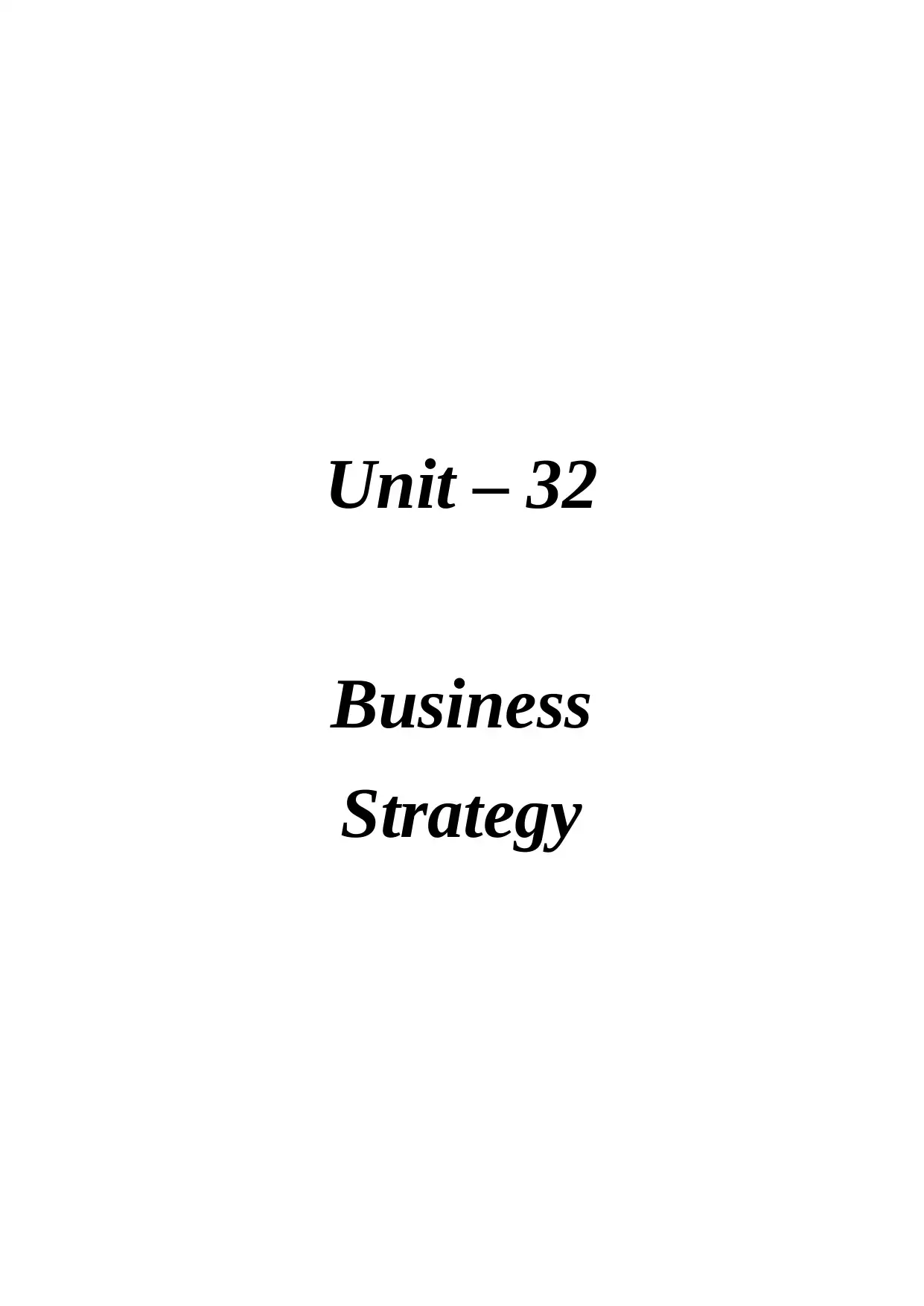
Unit – 32
Business
Strategy
Business
Strategy
Secure Best Marks with AI Grader
Need help grading? Try our AI Grader for instant feedback on your assignments.
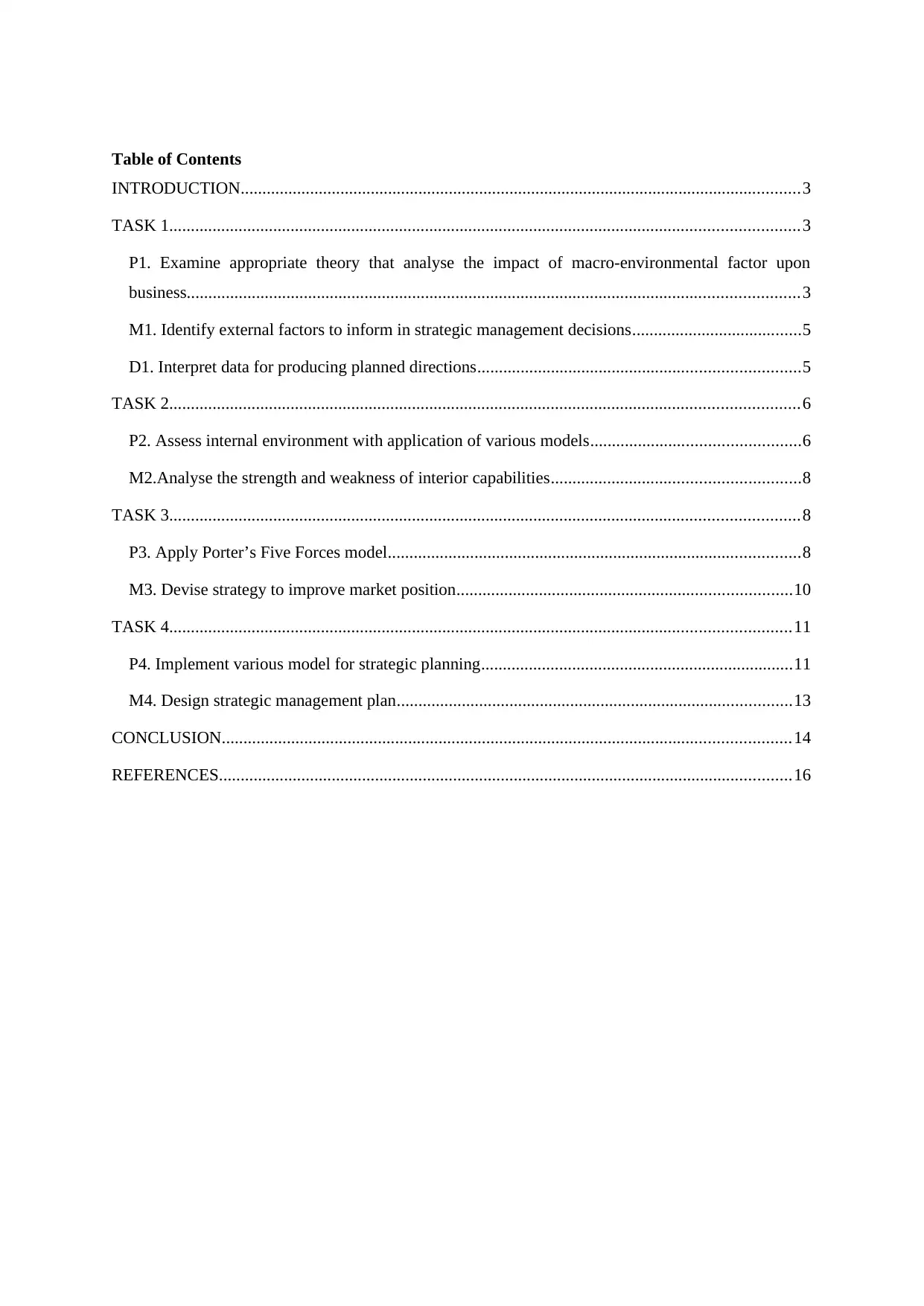
Table of Contents
INTRODUCTION.................................................................................................................................3
TASK 1.................................................................................................................................................3
P1. Examine appropriate theory that analyse the impact of macro-environmental factor upon
business.............................................................................................................................................3
M1. Identify external factors to inform in strategic management decisions.......................................5
D1. Interpret data for producing planned directions..........................................................................5
TASK 2.................................................................................................................................................6
P2. Assess internal environment with application of various models................................................6
M2.Analyse the strength and weakness of interior capabilities.........................................................8
TASK 3.................................................................................................................................................8
P3. Apply Porter’s Five Forces model...............................................................................................8
M3. Devise strategy to improve market position.............................................................................10
TASK 4...............................................................................................................................................11
P4. Implement various model for strategic planning........................................................................11
M4. Design strategic management plan...........................................................................................13
CONCLUSION...................................................................................................................................14
REFERENCES....................................................................................................................................16
INTRODUCTION.................................................................................................................................3
TASK 1.................................................................................................................................................3
P1. Examine appropriate theory that analyse the impact of macro-environmental factor upon
business.............................................................................................................................................3
M1. Identify external factors to inform in strategic management decisions.......................................5
D1. Interpret data for producing planned directions..........................................................................5
TASK 2.................................................................................................................................................6
P2. Assess internal environment with application of various models................................................6
M2.Analyse the strength and weakness of interior capabilities.........................................................8
TASK 3.................................................................................................................................................8
P3. Apply Porter’s Five Forces model...............................................................................................8
M3. Devise strategy to improve market position.............................................................................10
TASK 4...............................................................................................................................................11
P4. Implement various model for strategic planning........................................................................11
M4. Design strategic management plan...........................................................................................13
CONCLUSION...................................................................................................................................14
REFERENCES....................................................................................................................................16
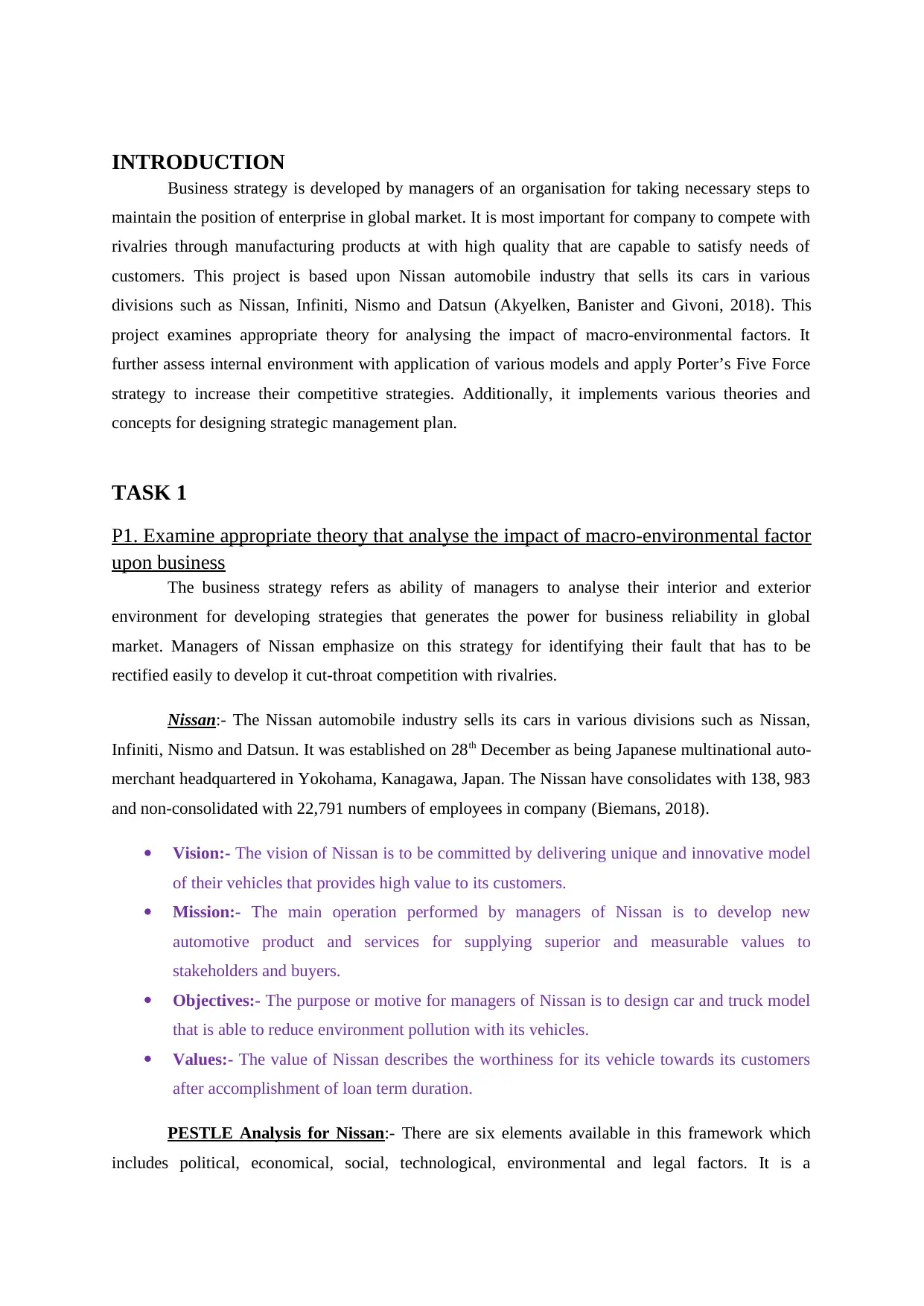
INTRODUCTION
Business strategy is developed by managers of an organisation for taking necessary steps to
maintain the position of enterprise in global market. It is most important for company to compete with
rivalries through manufacturing products at with high quality that are capable to satisfy needs of
customers. This project is based upon Nissan automobile industry that sells its cars in various
divisions such as Nissan, Infiniti, Nismo and Datsun (Akyelken, Banister and Givoni, 2018). This
project examines appropriate theory for analysing the impact of macro-environmental factors. It
further assess internal environment with application of various models and apply Porter’s Five Force
strategy to increase their competitive strategies. Additionally, it implements various theories and
concepts for designing strategic management plan.
TASK 1
P1. Examine appropriate theory that analyse the impact of macro-environmental factor
upon business
The business strategy refers as ability of managers to analyse their interior and exterior
environment for developing strategies that generates the power for business reliability in global
market. Managers of Nissan emphasize on this strategy for identifying their fault that has to be
rectified easily to develop it cut-throat competition with rivalries.
Nissan:- The Nissan automobile industry sells its cars in various divisions such as Nissan,
Infiniti, Nismo and Datsun. It was established on 28th December as being Japanese multinational auto-
merchant headquartered in Yokohama, Kanagawa, Japan. The Nissan have consolidates with 138, 983
and non-consolidated with 22,791 numbers of employees in company (Biemans, 2018).
Vision:- The vision of Nissan is to be committed by delivering unique and innovative model
of their vehicles that provides high value to its customers.
Mission:- The main operation performed by managers of Nissan is to develop new
automotive product and services for supplying superior and measurable values to
stakeholders and buyers.
Objectives:- The purpose or motive for managers of Nissan is to design car and truck model
that is able to reduce environment pollution with its vehicles.
Values:- The value of Nissan describes the worthiness for its vehicle towards its customers
after accomplishment of loan term duration.
PESTLE Analysis for Nissan:- There are six elements available in this framework which
includes political, economical, social, technological, environmental and legal factors. It is a
Business strategy is developed by managers of an organisation for taking necessary steps to
maintain the position of enterprise in global market. It is most important for company to compete with
rivalries through manufacturing products at with high quality that are capable to satisfy needs of
customers. This project is based upon Nissan automobile industry that sells its cars in various
divisions such as Nissan, Infiniti, Nismo and Datsun (Akyelken, Banister and Givoni, 2018). This
project examines appropriate theory for analysing the impact of macro-environmental factors. It
further assess internal environment with application of various models and apply Porter’s Five Force
strategy to increase their competitive strategies. Additionally, it implements various theories and
concepts for designing strategic management plan.
TASK 1
P1. Examine appropriate theory that analyse the impact of macro-environmental factor
upon business
The business strategy refers as ability of managers to analyse their interior and exterior
environment for developing strategies that generates the power for business reliability in global
market. Managers of Nissan emphasize on this strategy for identifying their fault that has to be
rectified easily to develop it cut-throat competition with rivalries.
Nissan:- The Nissan automobile industry sells its cars in various divisions such as Nissan,
Infiniti, Nismo and Datsun. It was established on 28th December as being Japanese multinational auto-
merchant headquartered in Yokohama, Kanagawa, Japan. The Nissan have consolidates with 138, 983
and non-consolidated with 22,791 numbers of employees in company (Biemans, 2018).
Vision:- The vision of Nissan is to be committed by delivering unique and innovative model
of their vehicles that provides high value to its customers.
Mission:- The main operation performed by managers of Nissan is to develop new
automotive product and services for supplying superior and measurable values to
stakeholders and buyers.
Objectives:- The purpose or motive for managers of Nissan is to design car and truck model
that is able to reduce environment pollution with its vehicles.
Values:- The value of Nissan describes the worthiness for its vehicle towards its customers
after accomplishment of loan term duration.
PESTLE Analysis for Nissan:- There are six elements available in this framework which
includes political, economical, social, technological, environmental and legal factors. It is a
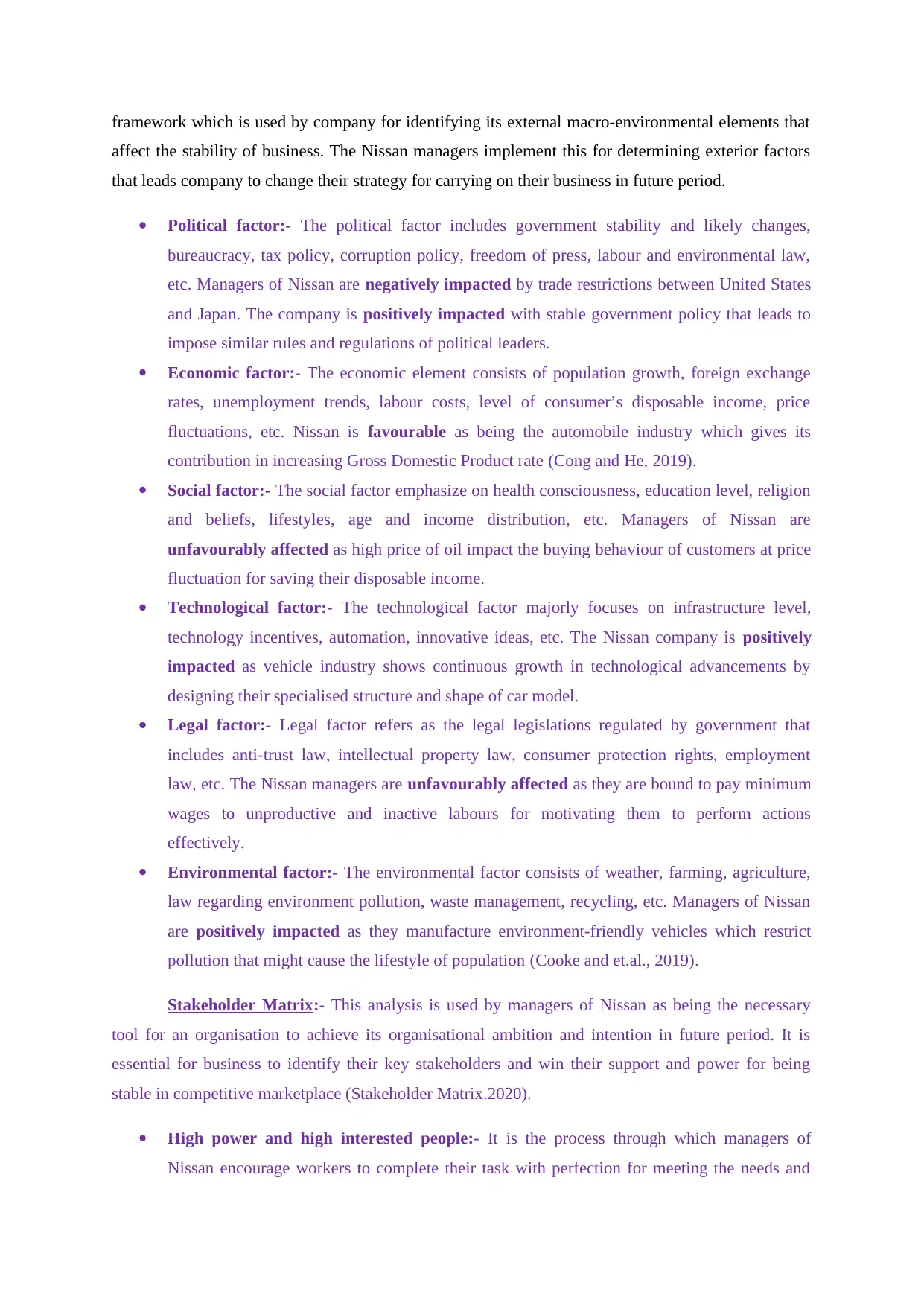
framework which is used by company for identifying its external macro-environmental elements that
affect the stability of business. The Nissan managers implement this for determining exterior factors
that leads company to change their strategy for carrying on their business in future period.
Political factor:- The political factor includes government stability and likely changes,
bureaucracy, tax policy, corruption policy, freedom of press, labour and environmental law,
etc. Managers of Nissan are negatively impacted by trade restrictions between United States
and Japan. The company is positively impacted with stable government policy that leads to
impose similar rules and regulations of political leaders.
Economic factor:- The economic element consists of population growth, foreign exchange
rates, unemployment trends, labour costs, level of consumer’s disposable income, price
fluctuations, etc. Nissan is favourable as being the automobile industry which gives its
contribution in increasing Gross Domestic Product rate (Cong and He, 2019).
Social factor:- The social factor emphasize on health consciousness, education level, religion
and beliefs, lifestyles, age and income distribution, etc. Managers of Nissan are
unfavourably affected as high price of oil impact the buying behaviour of customers at price
fluctuation for saving their disposable income.
Technological factor:- The technological factor majorly focuses on infrastructure level,
technology incentives, automation, innovative ideas, etc. The Nissan company is positively
impacted as vehicle industry shows continuous growth in technological advancements by
designing their specialised structure and shape of car model.
Legal factor:- Legal factor refers as the legal legislations regulated by government that
includes anti-trust law, intellectual property law, consumer protection rights, employment
law, etc. The Nissan managers are unfavourably affected as they are bound to pay minimum
wages to unproductive and inactive labours for motivating them to perform actions
effectively.
Environmental factor:- The environmental factor consists of weather, farming, agriculture,
law regarding environment pollution, waste management, recycling, etc. Managers of Nissan
are positively impacted as they manufacture environment-friendly vehicles which restrict
pollution that might cause the lifestyle of population (Cooke and et.al., 2019).
Stakeholder Matrix:- This analysis is used by managers of Nissan as being the necessary
tool for an organisation to achieve its organisational ambition and intention in future period. It is
essential for business to identify their key stakeholders and win their support and power for being
stable in competitive marketplace (Stakeholder Matrix.2020).
High power and high interested people:- It is the process through which managers of
Nissan encourage workers to complete their task with perfection for meeting the needs and
affect the stability of business. The Nissan managers implement this for determining exterior factors
that leads company to change their strategy for carrying on their business in future period.
Political factor:- The political factor includes government stability and likely changes,
bureaucracy, tax policy, corruption policy, freedom of press, labour and environmental law,
etc. Managers of Nissan are negatively impacted by trade restrictions between United States
and Japan. The company is positively impacted with stable government policy that leads to
impose similar rules and regulations of political leaders.
Economic factor:- The economic element consists of population growth, foreign exchange
rates, unemployment trends, labour costs, level of consumer’s disposable income, price
fluctuations, etc. Nissan is favourable as being the automobile industry which gives its
contribution in increasing Gross Domestic Product rate (Cong and He, 2019).
Social factor:- The social factor emphasize on health consciousness, education level, religion
and beliefs, lifestyles, age and income distribution, etc. Managers of Nissan are
unfavourably affected as high price of oil impact the buying behaviour of customers at price
fluctuation for saving their disposable income.
Technological factor:- The technological factor majorly focuses on infrastructure level,
technology incentives, automation, innovative ideas, etc. The Nissan company is positively
impacted as vehicle industry shows continuous growth in technological advancements by
designing their specialised structure and shape of car model.
Legal factor:- Legal factor refers as the legal legislations regulated by government that
includes anti-trust law, intellectual property law, consumer protection rights, employment
law, etc. The Nissan managers are unfavourably affected as they are bound to pay minimum
wages to unproductive and inactive labours for motivating them to perform actions
effectively.
Environmental factor:- The environmental factor consists of weather, farming, agriculture,
law regarding environment pollution, waste management, recycling, etc. Managers of Nissan
are positively impacted as they manufacture environment-friendly vehicles which restrict
pollution that might cause the lifestyle of population (Cooke and et.al., 2019).
Stakeholder Matrix:- This analysis is used by managers of Nissan as being the necessary
tool for an organisation to achieve its organisational ambition and intention in future period. It is
essential for business to identify their key stakeholders and win their support and power for being
stable in competitive marketplace (Stakeholder Matrix.2020).
High power and high interested people:- It is the process through which managers of
Nissan encourage workers to complete their task with perfection for meeting the needs and
Secure Best Marks with AI Grader
Need help grading? Try our AI Grader for instant feedback on your assignments.
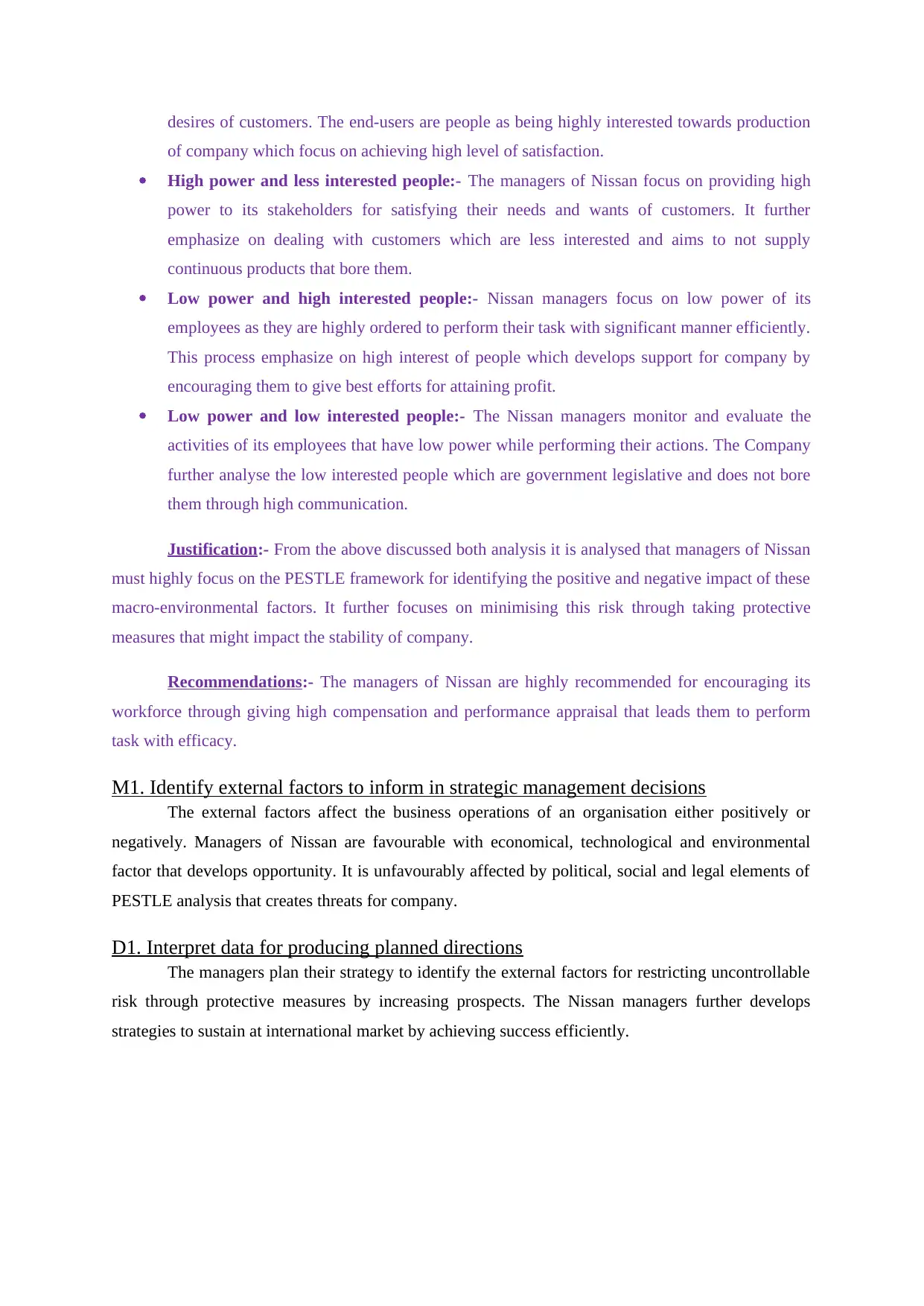
desires of customers. The end-users are people as being highly interested towards production
of company which focus on achieving high level of satisfaction.
High power and less interested people:- The managers of Nissan focus on providing high
power to its stakeholders for satisfying their needs and wants of customers. It further
emphasize on dealing with customers which are less interested and aims to not supply
continuous products that bore them.
Low power and high interested people:- Nissan managers focus on low power of its
employees as they are highly ordered to perform their task with significant manner efficiently.
This process emphasize on high interest of people which develops support for company by
encouraging them to give best efforts for attaining profit.
Low power and low interested people:- The Nissan managers monitor and evaluate the
activities of its employees that have low power while performing their actions. The Company
further analyse the low interested people which are government legislative and does not bore
them through high communication.
Justification:- From the above discussed both analysis it is analysed that managers of Nissan
must highly focus on the PESTLE framework for identifying the positive and negative impact of these
macro-environmental factors. It further focuses on minimising this risk through taking protective
measures that might impact the stability of company.
Recommendations:- The managers of Nissan are highly recommended for encouraging its
workforce through giving high compensation and performance appraisal that leads them to perform
task with efficacy.
M1. Identify external factors to inform in strategic management decisions
The external factors affect the business operations of an organisation either positively or
negatively. Managers of Nissan are favourable with economical, technological and environmental
factor that develops opportunity. It is unfavourably affected by political, social and legal elements of
PESTLE analysis that creates threats for company.
D1. Interpret data for producing planned directions
The managers plan their strategy to identify the external factors for restricting uncontrollable
risk through protective measures by increasing prospects. The Nissan managers further develops
strategies to sustain at international market by achieving success efficiently.
of company which focus on achieving high level of satisfaction.
High power and less interested people:- The managers of Nissan focus on providing high
power to its stakeholders for satisfying their needs and wants of customers. It further
emphasize on dealing with customers which are less interested and aims to not supply
continuous products that bore them.
Low power and high interested people:- Nissan managers focus on low power of its
employees as they are highly ordered to perform their task with significant manner efficiently.
This process emphasize on high interest of people which develops support for company by
encouraging them to give best efforts for attaining profit.
Low power and low interested people:- The Nissan managers monitor and evaluate the
activities of its employees that have low power while performing their actions. The Company
further analyse the low interested people which are government legislative and does not bore
them through high communication.
Justification:- From the above discussed both analysis it is analysed that managers of Nissan
must highly focus on the PESTLE framework for identifying the positive and negative impact of these
macro-environmental factors. It further focuses on minimising this risk through taking protective
measures that might impact the stability of company.
Recommendations:- The managers of Nissan are highly recommended for encouraging its
workforce through giving high compensation and performance appraisal that leads them to perform
task with efficacy.
M1. Identify external factors to inform in strategic management decisions
The external factors affect the business operations of an organisation either positively or
negatively. Managers of Nissan are favourable with economical, technological and environmental
factor that develops opportunity. It is unfavourably affected by political, social and legal elements of
PESTLE analysis that creates threats for company.
D1. Interpret data for producing planned directions
The managers plan their strategy to identify the external factors for restricting uncontrollable
risk through protective measures by increasing prospects. The Nissan managers further develops
strategies to sustain at international market by achieving success efficiently.
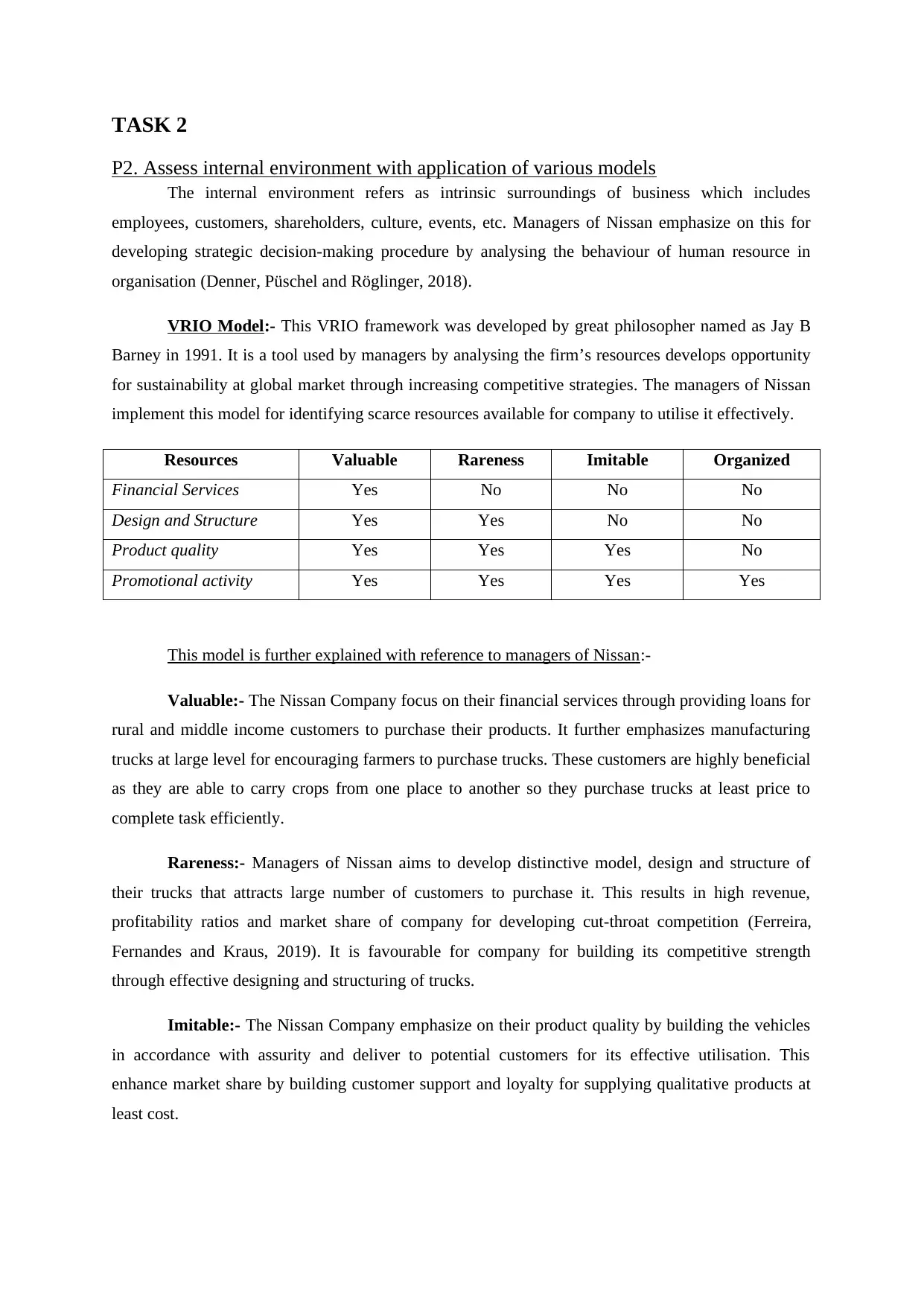
TASK 2
P2. Assess internal environment with application of various models
The internal environment refers as intrinsic surroundings of business which includes
employees, customers, shareholders, culture, events, etc. Managers of Nissan emphasize on this for
developing strategic decision-making procedure by analysing the behaviour of human resource in
organisation (Denner, Püschel and Röglinger, 2018).
VRIO Model:- This VRIO framework was developed by great philosopher named as Jay B
Barney in 1991. It is a tool used by managers by analysing the firm’s resources develops opportunity
for sustainability at global market through increasing competitive strategies. The managers of Nissan
implement this model for identifying scarce resources available for company to utilise it effectively.
Resources Valuable Rareness Imitable Organized
Financial Services Yes No No No
Design and Structure Yes Yes No No
Product quality Yes Yes Yes No
Promotional activity Yes Yes Yes Yes
This model is further explained with reference to managers of Nissan:-
Valuable:- The Nissan Company focus on their financial services through providing loans for
rural and middle income customers to purchase their products. It further emphasizes manufacturing
trucks at large level for encouraging farmers to purchase trucks. These customers are highly beneficial
as they are able to carry crops from one place to another so they purchase trucks at least price to
complete task efficiently.
Rareness:- Managers of Nissan aims to develop distinctive model, design and structure of
their trucks that attracts large number of customers to purchase it. This results in high revenue,
profitability ratios and market share of company for developing cut-throat competition (Ferreira,
Fernandes and Kraus, 2019). It is favourable for company for building its competitive strength
through effective designing and structuring of trucks.
Imitable:- The Nissan Company emphasize on their product quality by building the vehicles
in accordance with assurity and deliver to potential customers for its effective utilisation. This
enhance market share by building customer support and loyalty for supplying qualitative products at
least cost.
P2. Assess internal environment with application of various models
The internal environment refers as intrinsic surroundings of business which includes
employees, customers, shareholders, culture, events, etc. Managers of Nissan emphasize on this for
developing strategic decision-making procedure by analysing the behaviour of human resource in
organisation (Denner, Püschel and Röglinger, 2018).
VRIO Model:- This VRIO framework was developed by great philosopher named as Jay B
Barney in 1991. It is a tool used by managers by analysing the firm’s resources develops opportunity
for sustainability at global market through increasing competitive strategies. The managers of Nissan
implement this model for identifying scarce resources available for company to utilise it effectively.
Resources Valuable Rareness Imitable Organized
Financial Services Yes No No No
Design and Structure Yes Yes No No
Product quality Yes Yes Yes No
Promotional activity Yes Yes Yes Yes
This model is further explained with reference to managers of Nissan:-
Valuable:- The Nissan Company focus on their financial services through providing loans for
rural and middle income customers to purchase their products. It further emphasizes manufacturing
trucks at large level for encouraging farmers to purchase trucks. These customers are highly beneficial
as they are able to carry crops from one place to another so they purchase trucks at least price to
complete task efficiently.
Rareness:- Managers of Nissan aims to develop distinctive model, design and structure of
their trucks that attracts large number of customers to purchase it. This results in high revenue,
profitability ratios and market share of company for developing cut-throat competition (Ferreira,
Fernandes and Kraus, 2019). It is favourable for company for building its competitive strength
through effective designing and structuring of trucks.
Imitable:- The Nissan Company emphasize on their product quality by building the vehicles
in accordance with assurity and deliver to potential customers for its effective utilisation. This
enhance market share by building customer support and loyalty for supplying qualitative products at
least cost.
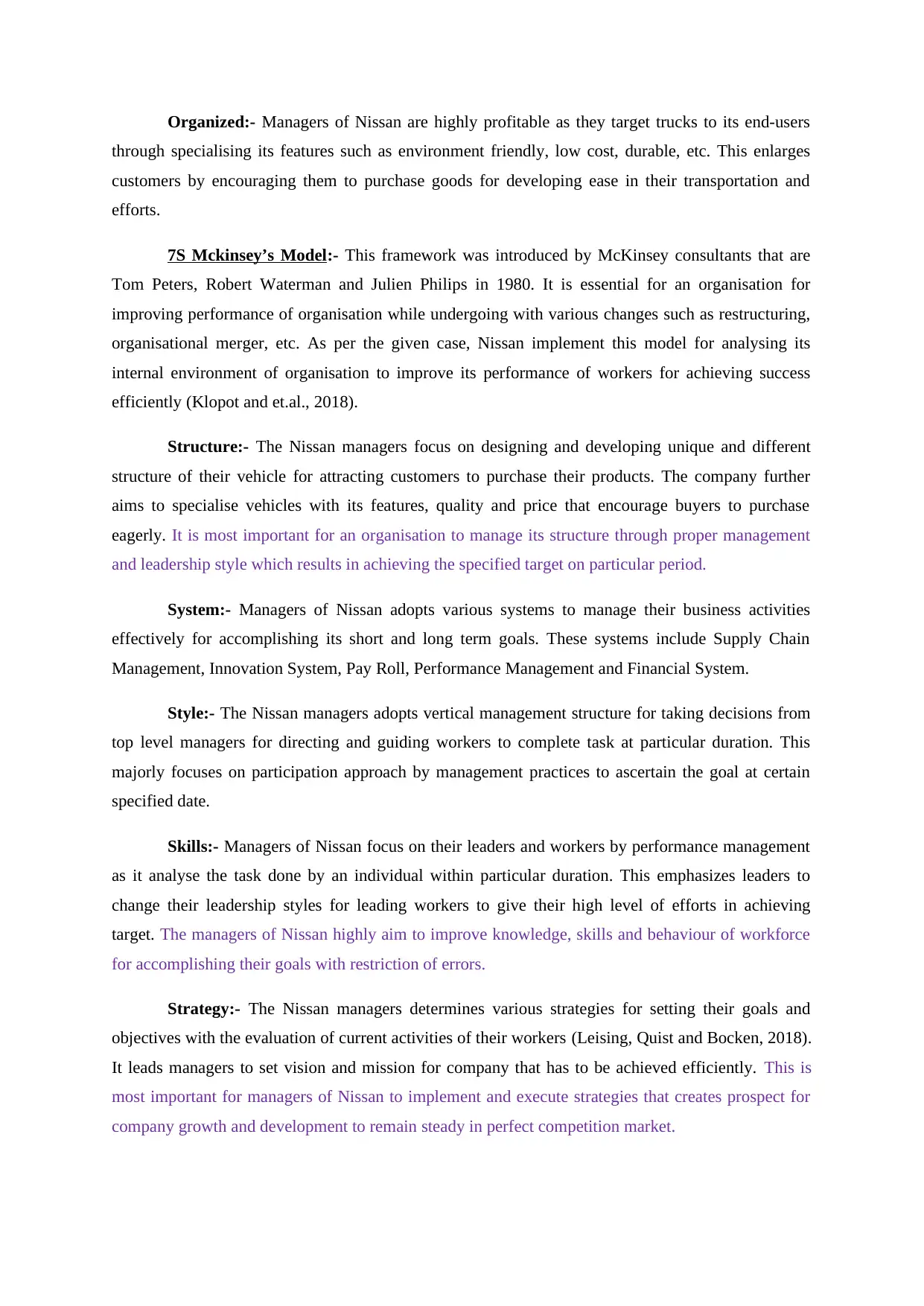
Organized:- Managers of Nissan are highly profitable as they target trucks to its end-users
through specialising its features such as environment friendly, low cost, durable, etc. This enlarges
customers by encouraging them to purchase goods for developing ease in their transportation and
efforts.
7S Mckinsey’s Model:- This framework was introduced by McKinsey consultants that are
Tom Peters, Robert Waterman and Julien Philips in 1980. It is essential for an organisation for
improving performance of organisation while undergoing with various changes such as restructuring,
organisational merger, etc. As per the given case, Nissan implement this model for analysing its
internal environment of organisation to improve its performance of workers for achieving success
efficiently (Klopot and et.al., 2018).
Structure:- The Nissan managers focus on designing and developing unique and different
structure of their vehicle for attracting customers to purchase their products. The company further
aims to specialise vehicles with its features, quality and price that encourage buyers to purchase
eagerly. It is most important for an organisation to manage its structure through proper management
and leadership style which results in achieving the specified target on particular period.
System:- Managers of Nissan adopts various systems to manage their business activities
effectively for accomplishing its short and long term goals. These systems include Supply Chain
Management, Innovation System, Pay Roll, Performance Management and Financial System.
Style:- The Nissan managers adopts vertical management structure for taking decisions from
top level managers for directing and guiding workers to complete task at particular duration. This
majorly focuses on participation approach by management practices to ascertain the goal at certain
specified date.
Skills:- Managers of Nissan focus on their leaders and workers by performance management
as it analyse the task done by an individual within particular duration. This emphasizes leaders to
change their leadership styles for leading workers to give their high level of efforts in achieving
target. The managers of Nissan highly aim to improve knowledge, skills and behaviour of workforce
for accomplishing their goals with restriction of errors.
Strategy:- The Nissan managers determines various strategies for setting their goals and
objectives with the evaluation of current activities of their workers (Leising, Quist and Bocken, 2018).
It leads managers to set vision and mission for company that has to be achieved efficiently. This is
most important for managers of Nissan to implement and execute strategies that creates prospect for
company growth and development to remain steady in perfect competition market.
through specialising its features such as environment friendly, low cost, durable, etc. This enlarges
customers by encouraging them to purchase goods for developing ease in their transportation and
efforts.
7S Mckinsey’s Model:- This framework was introduced by McKinsey consultants that are
Tom Peters, Robert Waterman and Julien Philips in 1980. It is essential for an organisation for
improving performance of organisation while undergoing with various changes such as restructuring,
organisational merger, etc. As per the given case, Nissan implement this model for analysing its
internal environment of organisation to improve its performance of workers for achieving success
efficiently (Klopot and et.al., 2018).
Structure:- The Nissan managers focus on designing and developing unique and different
structure of their vehicle for attracting customers to purchase their products. The company further
aims to specialise vehicles with its features, quality and price that encourage buyers to purchase
eagerly. It is most important for an organisation to manage its structure through proper management
and leadership style which results in achieving the specified target on particular period.
System:- Managers of Nissan adopts various systems to manage their business activities
effectively for accomplishing its short and long term goals. These systems include Supply Chain
Management, Innovation System, Pay Roll, Performance Management and Financial System.
Style:- The Nissan managers adopts vertical management structure for taking decisions from
top level managers for directing and guiding workers to complete task at particular duration. This
majorly focuses on participation approach by management practices to ascertain the goal at certain
specified date.
Skills:- Managers of Nissan focus on their leaders and workers by performance management
as it analyse the task done by an individual within particular duration. This emphasizes leaders to
change their leadership styles for leading workers to give their high level of efforts in achieving
target. The managers of Nissan highly aim to improve knowledge, skills and behaviour of workforce
for accomplishing their goals with restriction of errors.
Strategy:- The Nissan managers determines various strategies for setting their goals and
objectives with the evaluation of current activities of their workers (Leising, Quist and Bocken, 2018).
It leads managers to set vision and mission for company that has to be achieved efficiently. This is
most important for managers of Nissan to implement and execute strategies that creates prospect for
company growth and development to remain steady in perfect competition market.
Paraphrase This Document
Need a fresh take? Get an instant paraphrase of this document with our AI Paraphraser
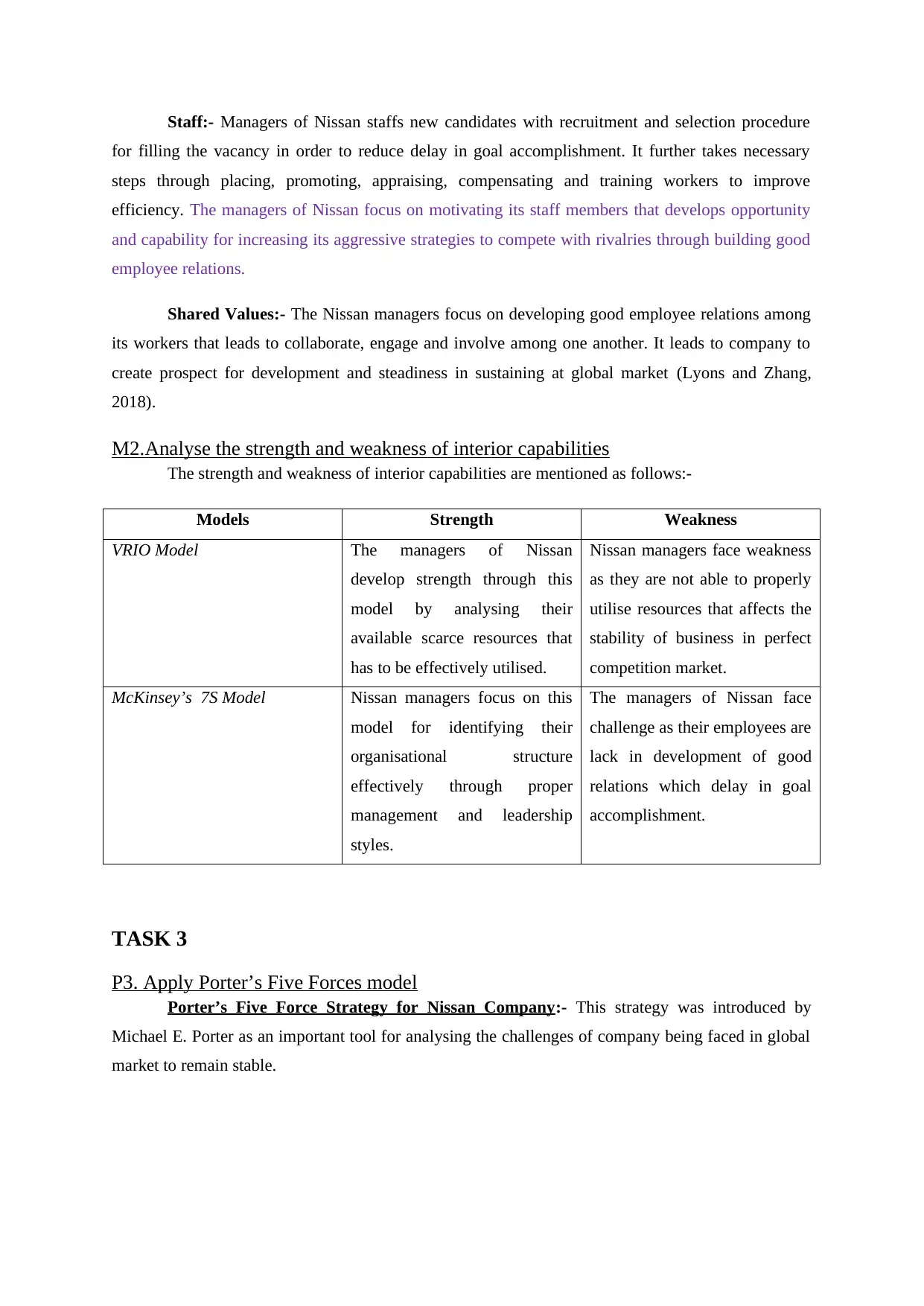
Staff:- Managers of Nissan staffs new candidates with recruitment and selection procedure
for filling the vacancy in order to reduce delay in goal accomplishment. It further takes necessary
steps through placing, promoting, appraising, compensating and training workers to improve
efficiency. The managers of Nissan focus on motivating its staff members that develops opportunity
and capability for increasing its aggressive strategies to compete with rivalries through building good
employee relations.
Shared Values:- The Nissan managers focus on developing good employee relations among
its workers that leads to collaborate, engage and involve among one another. It leads to company to
create prospect for development and steadiness in sustaining at global market (Lyons and Zhang,
2018).
M2.Analyse the strength and weakness of interior capabilities
The strength and weakness of interior capabilities are mentioned as follows:-
Models Strength Weakness
VRIO Model The managers of Nissan
develop strength through this
model by analysing their
available scarce resources that
has to be effectively utilised.
Nissan managers face weakness
as they are not able to properly
utilise resources that affects the
stability of business in perfect
competition market.
McKinsey’s 7S Model Nissan managers focus on this
model for identifying their
organisational structure
effectively through proper
management and leadership
styles.
The managers of Nissan face
challenge as their employees are
lack in development of good
relations which delay in goal
accomplishment.
TASK 3
P3. Apply Porter’s Five Forces model
Porter’s Five Force Strategy for Nissan Company:- This strategy was introduced by
Michael E. Porter as an important tool for analysing the challenges of company being faced in global
market to remain stable.
for filling the vacancy in order to reduce delay in goal accomplishment. It further takes necessary
steps through placing, promoting, appraising, compensating and training workers to improve
efficiency. The managers of Nissan focus on motivating its staff members that develops opportunity
and capability for increasing its aggressive strategies to compete with rivalries through building good
employee relations.
Shared Values:- The Nissan managers focus on developing good employee relations among
its workers that leads to collaborate, engage and involve among one another. It leads to company to
create prospect for development and steadiness in sustaining at global market (Lyons and Zhang,
2018).
M2.Analyse the strength and weakness of interior capabilities
The strength and weakness of interior capabilities are mentioned as follows:-
Models Strength Weakness
VRIO Model The managers of Nissan
develop strength through this
model by analysing their
available scarce resources that
has to be effectively utilised.
Nissan managers face weakness
as they are not able to properly
utilise resources that affects the
stability of business in perfect
competition market.
McKinsey’s 7S Model Nissan managers focus on this
model for identifying their
organisational structure
effectively through proper
management and leadership
styles.
The managers of Nissan face
challenge as their employees are
lack in development of good
relations which delay in goal
accomplishment.
TASK 3
P3. Apply Porter’s Five Forces model
Porter’s Five Force Strategy for Nissan Company:- This strategy was introduced by
Michael E. Porter as an important tool for analysing the challenges of company being faced in global
market to remain stable.
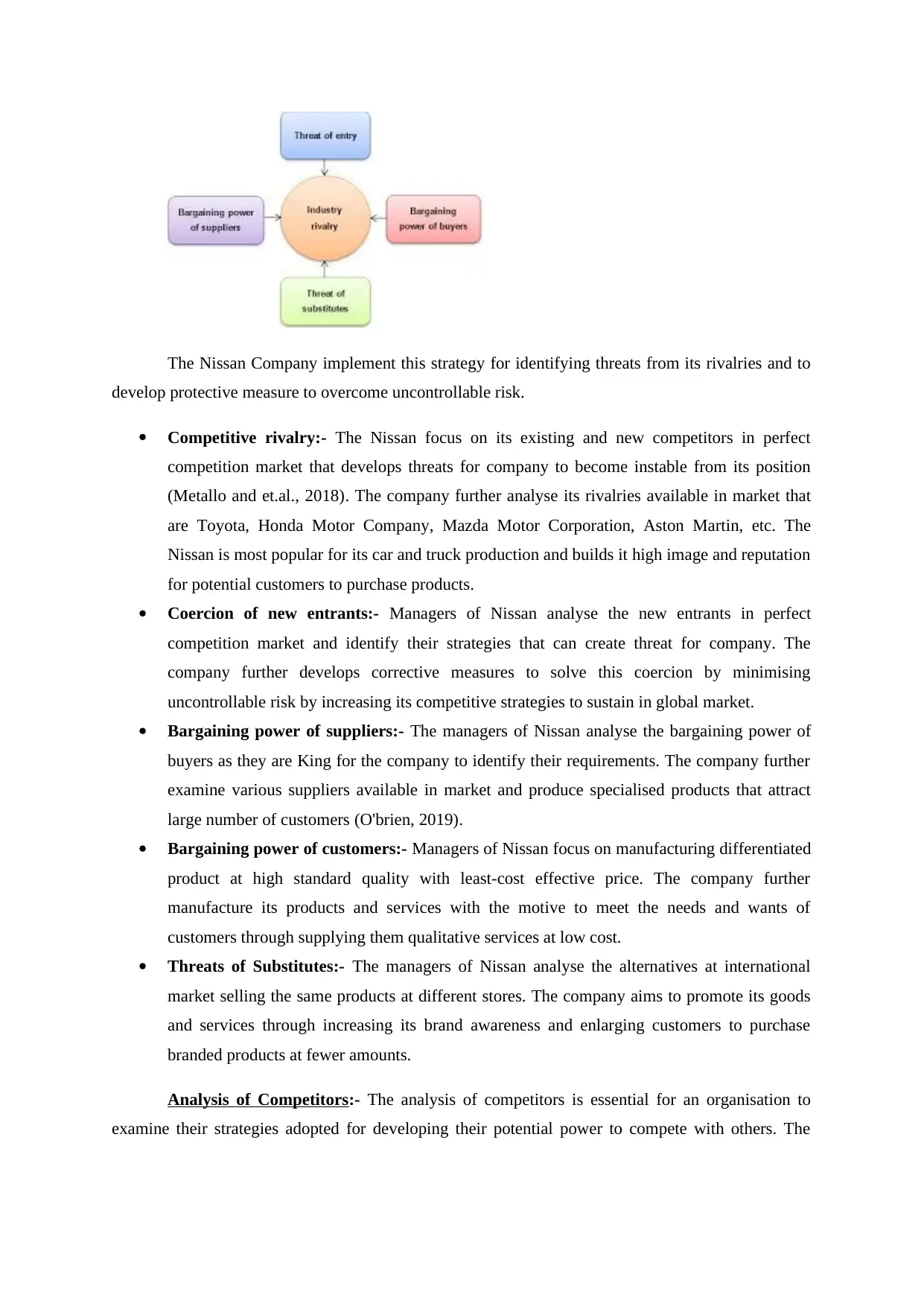
The Nissan Company implement this strategy for identifying threats from its rivalries and to
develop protective measure to overcome uncontrollable risk.
Competitive rivalry:- The Nissan focus on its existing and new competitors in perfect
competition market that develops threats for company to become instable from its position
(Metallo and et.al., 2018). The company further analyse its rivalries available in market that
are Toyota, Honda Motor Company, Mazda Motor Corporation, Aston Martin, etc. The
Nissan is most popular for its car and truck production and builds it high image and reputation
for potential customers to purchase products.
Coercion of new entrants:- Managers of Nissan analyse the new entrants in perfect
competition market and identify their strategies that can create threat for company. The
company further develops corrective measures to solve this coercion by minimising
uncontrollable risk by increasing its competitive strategies to sustain in global market.
Bargaining power of suppliers:- The managers of Nissan analyse the bargaining power of
buyers as they are King for the company to identify their requirements. The company further
examine various suppliers available in market and produce specialised products that attract
large number of customers (O'brien, 2019).
Bargaining power of customers:- Managers of Nissan focus on manufacturing differentiated
product at high standard quality with least-cost effective price. The company further
manufacture its products and services with the motive to meet the needs and wants of
customers through supplying them qualitative services at low cost.
Threats of Substitutes:- The managers of Nissan analyse the alternatives at international
market selling the same products at different stores. The company aims to promote its goods
and services through increasing its brand awareness and enlarging customers to purchase
branded products at fewer amounts.
Analysis of Competitors:- The analysis of competitors is essential for an organisation to
examine their strategies adopted for developing their potential power to compete with others. The
develop protective measure to overcome uncontrollable risk.
Competitive rivalry:- The Nissan focus on its existing and new competitors in perfect
competition market that develops threats for company to become instable from its position
(Metallo and et.al., 2018). The company further analyse its rivalries available in market that
are Toyota, Honda Motor Company, Mazda Motor Corporation, Aston Martin, etc. The
Nissan is most popular for its car and truck production and builds it high image and reputation
for potential customers to purchase products.
Coercion of new entrants:- Managers of Nissan analyse the new entrants in perfect
competition market and identify their strategies that can create threat for company. The
company further develops corrective measures to solve this coercion by minimising
uncontrollable risk by increasing its competitive strategies to sustain in global market.
Bargaining power of suppliers:- The managers of Nissan analyse the bargaining power of
buyers as they are King for the company to identify their requirements. The company further
examine various suppliers available in market and produce specialised products that attract
large number of customers (O'brien, 2019).
Bargaining power of customers:- Managers of Nissan focus on manufacturing differentiated
product at high standard quality with least-cost effective price. The company further
manufacture its products and services with the motive to meet the needs and wants of
customers through supplying them qualitative services at low cost.
Threats of Substitutes:- The managers of Nissan analyse the alternatives at international
market selling the same products at different stores. The company aims to promote its goods
and services through increasing its brand awareness and enlarging customers to purchase
branded products at fewer amounts.
Analysis of Competitors:- The analysis of competitors is essential for an organisation to
examine their strategies adopted for developing their potential power to compete with others. The
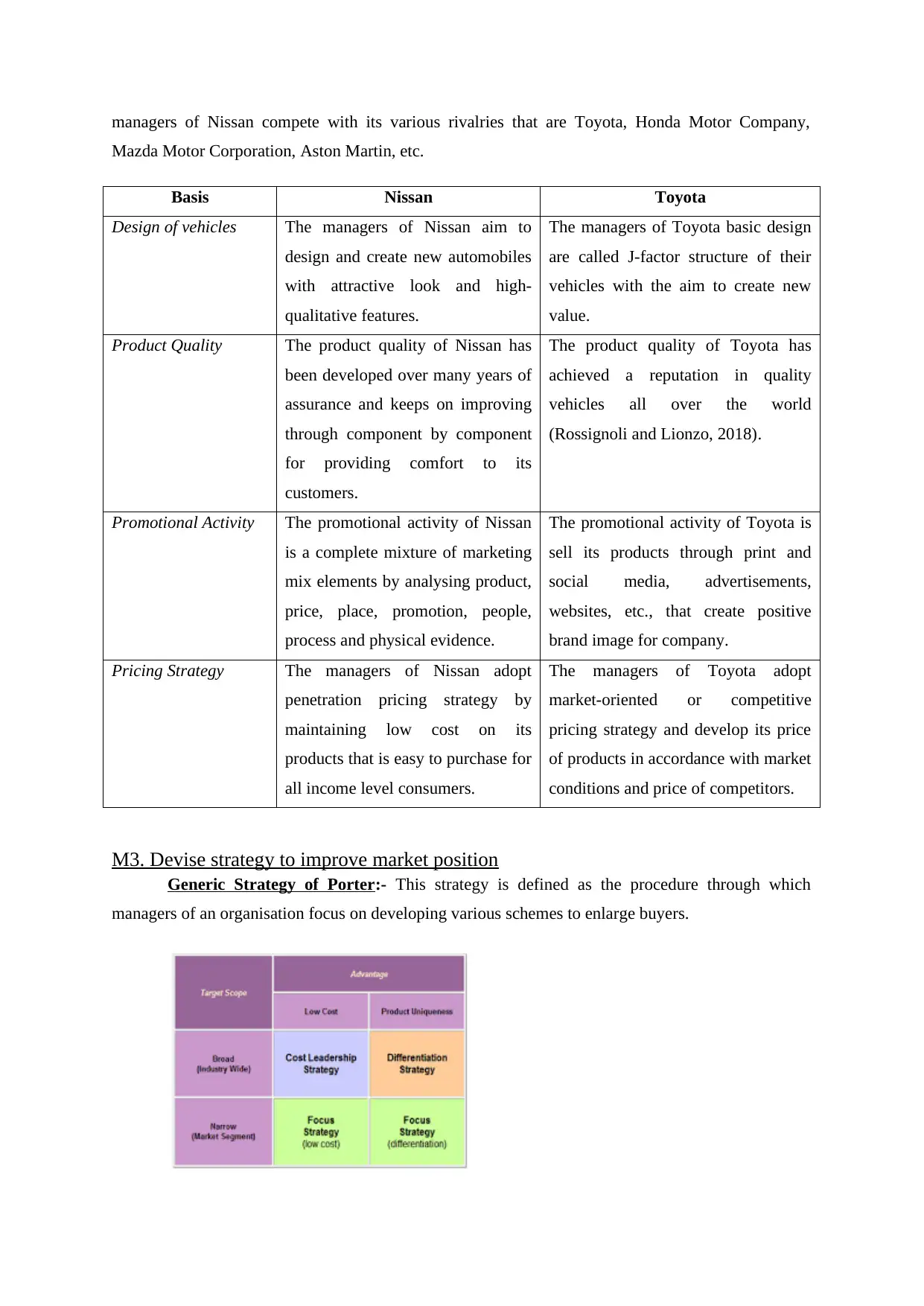
managers of Nissan compete with its various rivalries that are Toyota, Honda Motor Company,
Mazda Motor Corporation, Aston Martin, etc.
Basis Nissan Toyota
Design of vehicles The managers of Nissan aim to
design and create new automobiles
with attractive look and high-
qualitative features.
The managers of Toyota basic design
are called J-factor structure of their
vehicles with the aim to create new
value.
Product Quality The product quality of Nissan has
been developed over many years of
assurance and keeps on improving
through component by component
for providing comfort to its
customers.
The product quality of Toyota has
achieved a reputation in quality
vehicles all over the world
(Rossignoli and Lionzo, 2018).
Promotional Activity The promotional activity of Nissan
is a complete mixture of marketing
mix elements by analysing product,
price, place, promotion, people,
process and physical evidence.
The promotional activity of Toyota is
sell its products through print and
social media, advertisements,
websites, etc., that create positive
brand image for company.
Pricing Strategy The managers of Nissan adopt
penetration pricing strategy by
maintaining low cost on its
products that is easy to purchase for
all income level consumers.
The managers of Toyota adopt
market-oriented or competitive
pricing strategy and develop its price
of products in accordance with market
conditions and price of competitors.
M3. Devise strategy to improve market position
Generic Strategy of Porter:- This strategy is defined as the procedure through which
managers of an organisation focus on developing various schemes to enlarge buyers.
Mazda Motor Corporation, Aston Martin, etc.
Basis Nissan Toyota
Design of vehicles The managers of Nissan aim to
design and create new automobiles
with attractive look and high-
qualitative features.
The managers of Toyota basic design
are called J-factor structure of their
vehicles with the aim to create new
value.
Product Quality The product quality of Nissan has
been developed over many years of
assurance and keeps on improving
through component by component
for providing comfort to its
customers.
The product quality of Toyota has
achieved a reputation in quality
vehicles all over the world
(Rossignoli and Lionzo, 2018).
Promotional Activity The promotional activity of Nissan
is a complete mixture of marketing
mix elements by analysing product,
price, place, promotion, people,
process and physical evidence.
The promotional activity of Toyota is
sell its products through print and
social media, advertisements,
websites, etc., that create positive
brand image for company.
Pricing Strategy The managers of Nissan adopt
penetration pricing strategy by
maintaining low cost on its
products that is easy to purchase for
all income level consumers.
The managers of Toyota adopt
market-oriented or competitive
pricing strategy and develop its price
of products in accordance with market
conditions and price of competitors.
M3. Devise strategy to improve market position
Generic Strategy of Porter:- This strategy is defined as the procedure through which
managers of an organisation focus on developing various schemes to enlarge buyers.
Secure Best Marks with AI Grader
Need help grading? Try our AI Grader for instant feedback on your assignments.
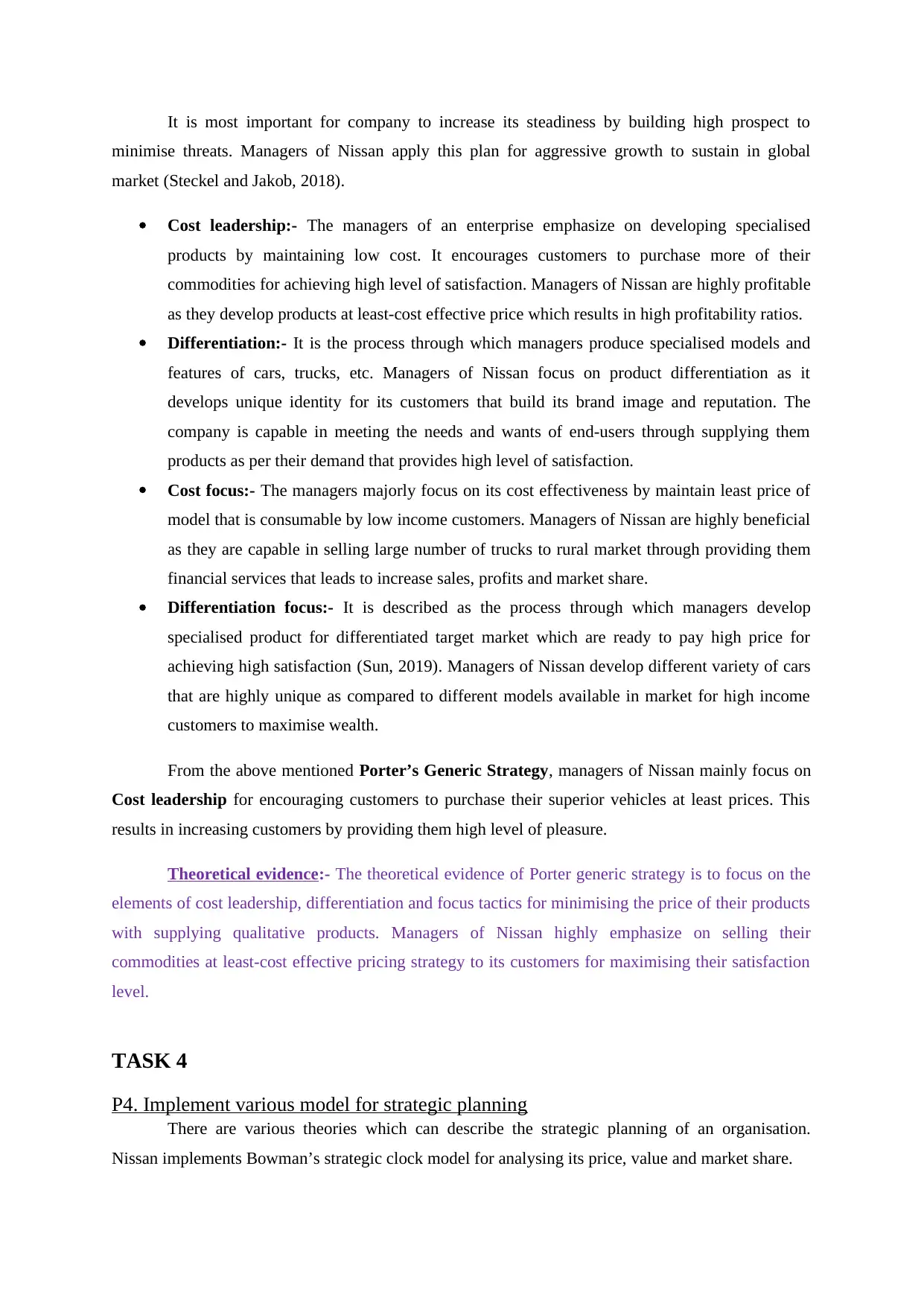
It is most important for company to increase its steadiness by building high prospect to
minimise threats. Managers of Nissan apply this plan for aggressive growth to sustain in global
market (Steckel and Jakob, 2018).
Cost leadership:- The managers of an enterprise emphasize on developing specialised
products by maintaining low cost. It encourages customers to purchase more of their
commodities for achieving high level of satisfaction. Managers of Nissan are highly profitable
as they develop products at least-cost effective price which results in high profitability ratios.
Differentiation:- It is the process through which managers produce specialised models and
features of cars, trucks, etc. Managers of Nissan focus on product differentiation as it
develops unique identity for its customers that build its brand image and reputation. The
company is capable in meeting the needs and wants of end-users through supplying them
products as per their demand that provides high level of satisfaction.
Cost focus:- The managers majorly focus on its cost effectiveness by maintain least price of
model that is consumable by low income customers. Managers of Nissan are highly beneficial
as they are capable in selling large number of trucks to rural market through providing them
financial services that leads to increase sales, profits and market share.
Differentiation focus:- It is described as the process through which managers develop
specialised product for differentiated target market which are ready to pay high price for
achieving high satisfaction (Sun, 2019). Managers of Nissan develop different variety of cars
that are highly unique as compared to different models available in market for high income
customers to maximise wealth.
From the above mentioned Porter’s Generic Strategy, managers of Nissan mainly focus on
Cost leadership for encouraging customers to purchase their superior vehicles at least prices. This
results in increasing customers by providing them high level of pleasure.
Theoretical evidence:- The theoretical evidence of Porter generic strategy is to focus on the
elements of cost leadership, differentiation and focus tactics for minimising the price of their products
with supplying qualitative products. Managers of Nissan highly emphasize on selling their
commodities at least-cost effective pricing strategy to its customers for maximising their satisfaction
level.
TASK 4
P4. Implement various model for strategic planning
There are various theories which can describe the strategic planning of an organisation.
Nissan implements Bowman’s strategic clock model for analysing its price, value and market share.
minimise threats. Managers of Nissan apply this plan for aggressive growth to sustain in global
market (Steckel and Jakob, 2018).
Cost leadership:- The managers of an enterprise emphasize on developing specialised
products by maintaining low cost. It encourages customers to purchase more of their
commodities for achieving high level of satisfaction. Managers of Nissan are highly profitable
as they develop products at least-cost effective price which results in high profitability ratios.
Differentiation:- It is the process through which managers produce specialised models and
features of cars, trucks, etc. Managers of Nissan focus on product differentiation as it
develops unique identity for its customers that build its brand image and reputation. The
company is capable in meeting the needs and wants of end-users through supplying them
products as per their demand that provides high level of satisfaction.
Cost focus:- The managers majorly focus on its cost effectiveness by maintain least price of
model that is consumable by low income customers. Managers of Nissan are highly beneficial
as they are capable in selling large number of trucks to rural market through providing them
financial services that leads to increase sales, profits and market share.
Differentiation focus:- It is described as the process through which managers develop
specialised product for differentiated target market which are ready to pay high price for
achieving high satisfaction (Sun, 2019). Managers of Nissan develop different variety of cars
that are highly unique as compared to different models available in market for high income
customers to maximise wealth.
From the above mentioned Porter’s Generic Strategy, managers of Nissan mainly focus on
Cost leadership for encouraging customers to purchase their superior vehicles at least prices. This
results in increasing customers by providing them high level of pleasure.
Theoretical evidence:- The theoretical evidence of Porter generic strategy is to focus on the
elements of cost leadership, differentiation and focus tactics for minimising the price of their products
with supplying qualitative products. Managers of Nissan highly emphasize on selling their
commodities at least-cost effective pricing strategy to its customers for maximising their satisfaction
level.
TASK 4
P4. Implement various model for strategic planning
There are various theories which can describe the strategic planning of an organisation.
Nissan implements Bowman’s strategic clock model for analysing its price, value and market share.
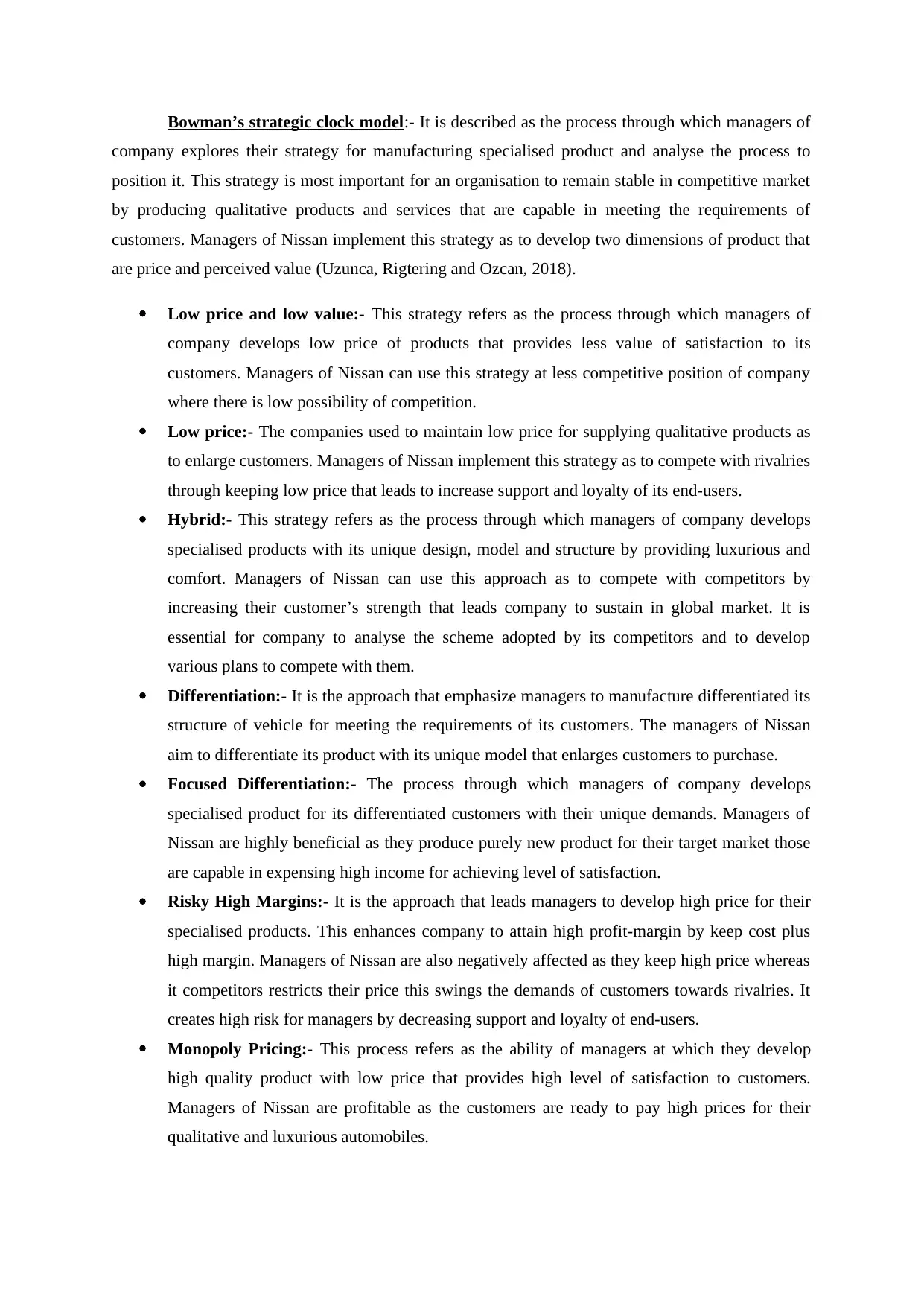
Bowman’s strategic clock model:- It is described as the process through which managers of
company explores their strategy for manufacturing specialised product and analyse the process to
position it. This strategy is most important for an organisation to remain stable in competitive market
by producing qualitative products and services that are capable in meeting the requirements of
customers. Managers of Nissan implement this strategy as to develop two dimensions of product that
are price and perceived value (Uzunca, Rigtering and Ozcan, 2018).
Low price and low value:- This strategy refers as the process through which managers of
company develops low price of products that provides less value of satisfaction to its
customers. Managers of Nissan can use this strategy at less competitive position of company
where there is low possibility of competition.
Low price:- The companies used to maintain low price for supplying qualitative products as
to enlarge customers. Managers of Nissan implement this strategy as to compete with rivalries
through keeping low price that leads to increase support and loyalty of its end-users.
Hybrid:- This strategy refers as the process through which managers of company develops
specialised products with its unique design, model and structure by providing luxurious and
comfort. Managers of Nissan can use this approach as to compete with competitors by
increasing their customer’s strength that leads company to sustain in global market. It is
essential for company to analyse the scheme adopted by its competitors and to develop
various plans to compete with them.
Differentiation:- It is the approach that emphasize managers to manufacture differentiated its
structure of vehicle for meeting the requirements of its customers. The managers of Nissan
aim to differentiate its product with its unique model that enlarges customers to purchase.
Focused Differentiation:- The process through which managers of company develops
specialised product for its differentiated customers with their unique demands. Managers of
Nissan are highly beneficial as they produce purely new product for their target market those
are capable in expensing high income for achieving level of satisfaction.
Risky High Margins:- It is the approach that leads managers to develop high price for their
specialised products. This enhances company to attain high profit-margin by keep cost plus
high margin. Managers of Nissan are also negatively affected as they keep high price whereas
it competitors restricts their price this swings the demands of customers towards rivalries. It
creates high risk for managers by decreasing support and loyalty of end-users.
Monopoly Pricing:- This process refers as the ability of managers at which they develop
high quality product with low price that provides high level of satisfaction to customers.
Managers of Nissan are profitable as the customers are ready to pay high prices for their
qualitative and luxurious automobiles.
company explores their strategy for manufacturing specialised product and analyse the process to
position it. This strategy is most important for an organisation to remain stable in competitive market
by producing qualitative products and services that are capable in meeting the requirements of
customers. Managers of Nissan implement this strategy as to develop two dimensions of product that
are price and perceived value (Uzunca, Rigtering and Ozcan, 2018).
Low price and low value:- This strategy refers as the process through which managers of
company develops low price of products that provides less value of satisfaction to its
customers. Managers of Nissan can use this strategy at less competitive position of company
where there is low possibility of competition.
Low price:- The companies used to maintain low price for supplying qualitative products as
to enlarge customers. Managers of Nissan implement this strategy as to compete with rivalries
through keeping low price that leads to increase support and loyalty of its end-users.
Hybrid:- This strategy refers as the process through which managers of company develops
specialised products with its unique design, model and structure by providing luxurious and
comfort. Managers of Nissan can use this approach as to compete with competitors by
increasing their customer’s strength that leads company to sustain in global market. It is
essential for company to analyse the scheme adopted by its competitors and to develop
various plans to compete with them.
Differentiation:- It is the approach that emphasize managers to manufacture differentiated its
structure of vehicle for meeting the requirements of its customers. The managers of Nissan
aim to differentiate its product with its unique model that enlarges customers to purchase.
Focused Differentiation:- The process through which managers of company develops
specialised product for its differentiated customers with their unique demands. Managers of
Nissan are highly beneficial as they produce purely new product for their target market those
are capable in expensing high income for achieving level of satisfaction.
Risky High Margins:- It is the approach that leads managers to develop high price for their
specialised products. This enhances company to attain high profit-margin by keep cost plus
high margin. Managers of Nissan are also negatively affected as they keep high price whereas
it competitors restricts their price this swings the demands of customers towards rivalries. It
creates high risk for managers by decreasing support and loyalty of end-users.
Monopoly Pricing:- This process refers as the ability of managers at which they develop
high quality product with low price that provides high level of satisfaction to customers.
Managers of Nissan are profitable as the customers are ready to pay high prices for their
qualitative and luxurious automobiles.
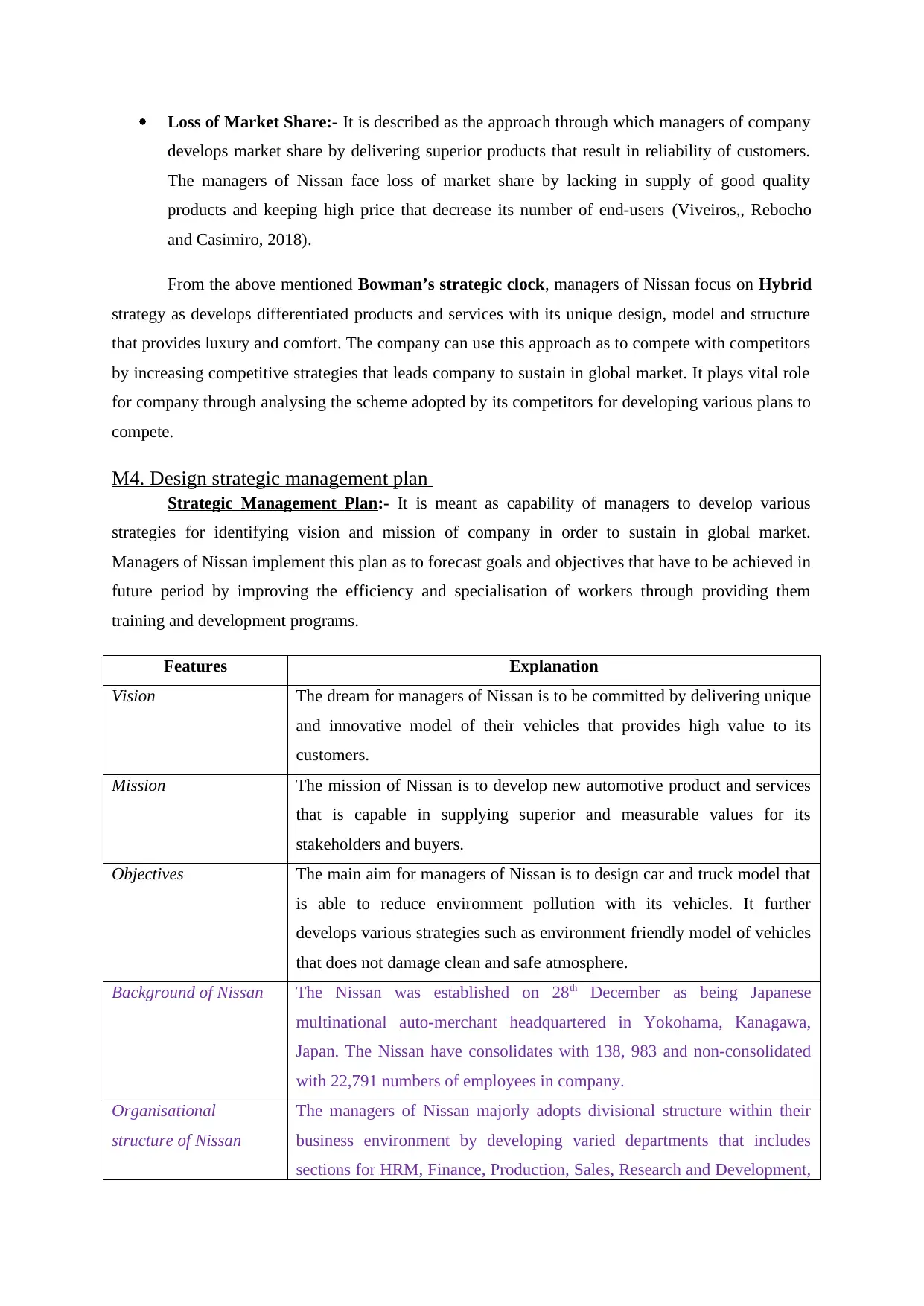
Loss of Market Share:- It is described as the approach through which managers of company
develops market share by delivering superior products that result in reliability of customers.
The managers of Nissan face loss of market share by lacking in supply of good quality
products and keeping high price that decrease its number of end-users (Viveiros,, Rebocho
and Casimiro, 2018).
From the above mentioned Bowman’s strategic clock, managers of Nissan focus on Hybrid
strategy as develops differentiated products and services with its unique design, model and structure
that provides luxury and comfort. The company can use this approach as to compete with competitors
by increasing competitive strategies that leads company to sustain in global market. It plays vital role
for company through analysing the scheme adopted by its competitors for developing various plans to
compete.
M4. Design strategic management plan
Strategic Management Plan:- It is meant as capability of managers to develop various
strategies for identifying vision and mission of company in order to sustain in global market.
Managers of Nissan implement this plan as to forecast goals and objectives that have to be achieved in
future period by improving the efficiency and specialisation of workers through providing them
training and development programs.
Features Explanation
Vision The dream for managers of Nissan is to be committed by delivering unique
and innovative model of their vehicles that provides high value to its
customers.
Mission The mission of Nissan is to develop new automotive product and services
that is capable in supplying superior and measurable values for its
stakeholders and buyers.
Objectives The main aim for managers of Nissan is to design car and truck model that
is able to reduce environment pollution with its vehicles. It further
develops various strategies such as environment friendly model of vehicles
that does not damage clean and safe atmosphere.
Background of Nissan The Nissan was established on 28th December as being Japanese
multinational auto-merchant headquartered in Yokohama, Kanagawa,
Japan. The Nissan have consolidates with 138, 983 and non-consolidated
with 22,791 numbers of employees in company.
Organisational
structure of Nissan
The managers of Nissan majorly adopts divisional structure within their
business environment by developing varied departments that includes
sections for HRM, Finance, Production, Sales, Research and Development,
develops market share by delivering superior products that result in reliability of customers.
The managers of Nissan face loss of market share by lacking in supply of good quality
products and keeping high price that decrease its number of end-users (Viveiros,, Rebocho
and Casimiro, 2018).
From the above mentioned Bowman’s strategic clock, managers of Nissan focus on Hybrid
strategy as develops differentiated products and services with its unique design, model and structure
that provides luxury and comfort. The company can use this approach as to compete with competitors
by increasing competitive strategies that leads company to sustain in global market. It plays vital role
for company through analysing the scheme adopted by its competitors for developing various plans to
compete.
M4. Design strategic management plan
Strategic Management Plan:- It is meant as capability of managers to develop various
strategies for identifying vision and mission of company in order to sustain in global market.
Managers of Nissan implement this plan as to forecast goals and objectives that have to be achieved in
future period by improving the efficiency and specialisation of workers through providing them
training and development programs.
Features Explanation
Vision The dream for managers of Nissan is to be committed by delivering unique
and innovative model of their vehicles that provides high value to its
customers.
Mission The mission of Nissan is to develop new automotive product and services
that is capable in supplying superior and measurable values for its
stakeholders and buyers.
Objectives The main aim for managers of Nissan is to design car and truck model that
is able to reduce environment pollution with its vehicles. It further
develops various strategies such as environment friendly model of vehicles
that does not damage clean and safe atmosphere.
Background of Nissan The Nissan was established on 28th December as being Japanese
multinational auto-merchant headquartered in Yokohama, Kanagawa,
Japan. The Nissan have consolidates with 138, 983 and non-consolidated
with 22,791 numbers of employees in company.
Organisational
structure of Nissan
The managers of Nissan majorly adopts divisional structure within their
business environment by developing varied departments that includes
sections for HRM, Finance, Production, Sales, Research and Development,
Paraphrase This Document
Need a fresh take? Get an instant paraphrase of this document with our AI Paraphraser
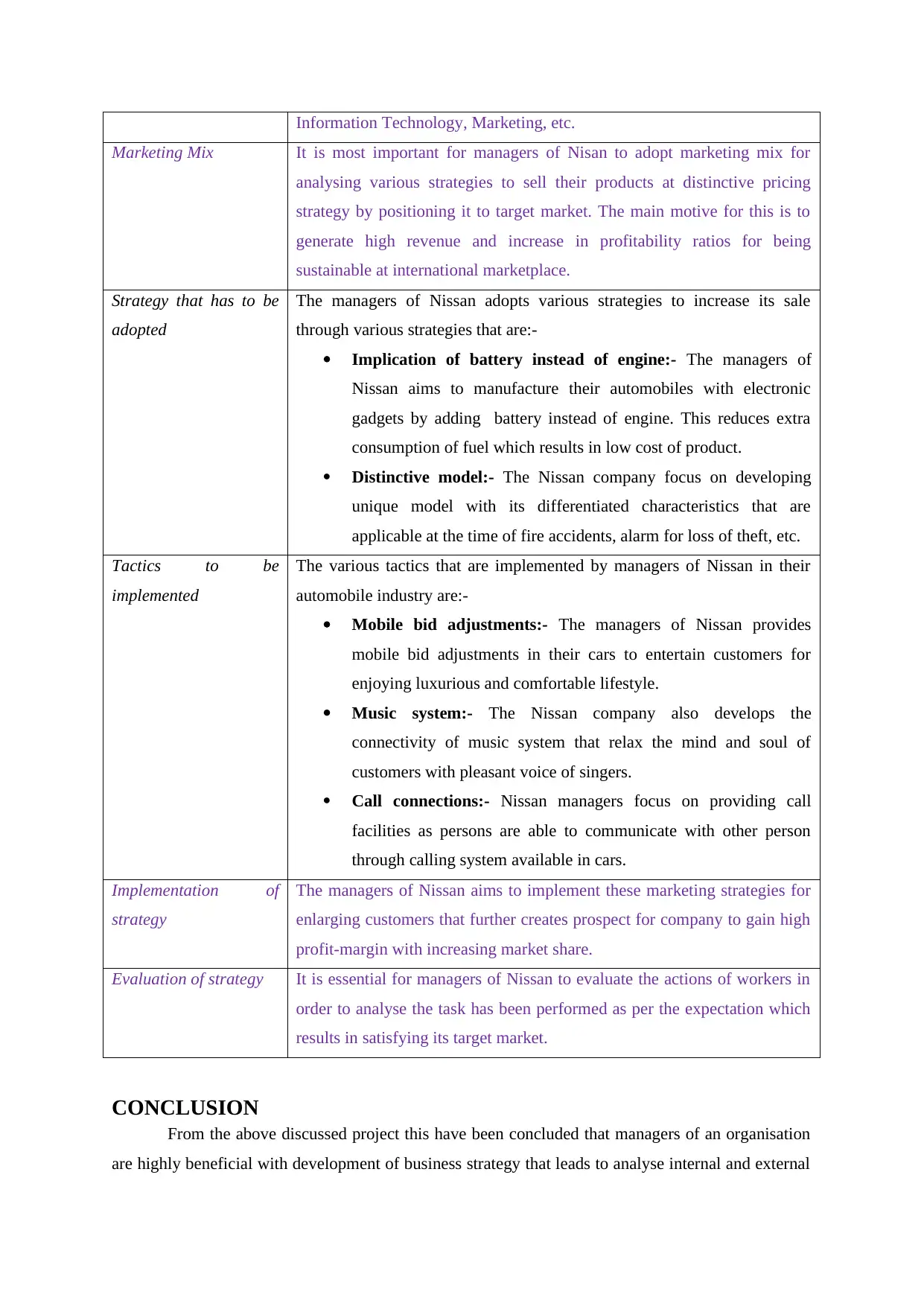
Information Technology, Marketing, etc.
Marketing Mix It is most important for managers of Nisan to adopt marketing mix for
analysing various strategies to sell their products at distinctive pricing
strategy by positioning it to target market. The main motive for this is to
generate high revenue and increase in profitability ratios for being
sustainable at international marketplace.
Strategy that has to be
adopted
The managers of Nissan adopts various strategies to increase its sale
through various strategies that are:-
Implication of battery instead of engine:- The managers of
Nissan aims to manufacture their automobiles with electronic
gadgets by adding battery instead of engine. This reduces extra
consumption of fuel which results in low cost of product.
Distinctive model:- The Nissan company focus on developing
unique model with its differentiated characteristics that are
applicable at the time of fire accidents, alarm for loss of theft, etc.
Tactics to be
implemented
The various tactics that are implemented by managers of Nissan in their
automobile industry are:-
Mobile bid adjustments:- The managers of Nissan provides
mobile bid adjustments in their cars to entertain customers for
enjoying luxurious and comfortable lifestyle.
Music system:- The Nissan company also develops the
connectivity of music system that relax the mind and soul of
customers with pleasant voice of singers.
Call connections:- Nissan managers focus on providing call
facilities as persons are able to communicate with other person
through calling system available in cars.
Implementation of
strategy
The managers of Nissan aims to implement these marketing strategies for
enlarging customers that further creates prospect for company to gain high
profit-margin with increasing market share.
Evaluation of strategy It is essential for managers of Nissan to evaluate the actions of workers in
order to analyse the task has been performed as per the expectation which
results in satisfying its target market.
CONCLUSION
From the above discussed project this have been concluded that managers of an organisation
are highly beneficial with development of business strategy that leads to analyse internal and external
Marketing Mix It is most important for managers of Nisan to adopt marketing mix for
analysing various strategies to sell their products at distinctive pricing
strategy by positioning it to target market. The main motive for this is to
generate high revenue and increase in profitability ratios for being
sustainable at international marketplace.
Strategy that has to be
adopted
The managers of Nissan adopts various strategies to increase its sale
through various strategies that are:-
Implication of battery instead of engine:- The managers of
Nissan aims to manufacture their automobiles with electronic
gadgets by adding battery instead of engine. This reduces extra
consumption of fuel which results in low cost of product.
Distinctive model:- The Nissan company focus on developing
unique model with its differentiated characteristics that are
applicable at the time of fire accidents, alarm for loss of theft, etc.
Tactics to be
implemented
The various tactics that are implemented by managers of Nissan in their
automobile industry are:-
Mobile bid adjustments:- The managers of Nissan provides
mobile bid adjustments in their cars to entertain customers for
enjoying luxurious and comfortable lifestyle.
Music system:- The Nissan company also develops the
connectivity of music system that relax the mind and soul of
customers with pleasant voice of singers.
Call connections:- Nissan managers focus on providing call
facilities as persons are able to communicate with other person
through calling system available in cars.
Implementation of
strategy
The managers of Nissan aims to implement these marketing strategies for
enlarging customers that further creates prospect for company to gain high
profit-margin with increasing market share.
Evaluation of strategy It is essential for managers of Nissan to evaluate the actions of workers in
order to analyse the task has been performed as per the expectation which
results in satisfying its target market.
CONCLUSION
From the above discussed project this have been concluded that managers of an organisation
are highly beneficial with development of business strategy that leads to analyse internal and external

factors that affect business positively or negatively. This project majorly examines the impact of
external factors through implementing PESTLE analysis that affect stability of business. It also
identifies the strength and weakness of interior capabilities with application of VRIO and Mckinsey’s
7S model. Apartly, it pertain Porter’s Five Force and Generic strategy to determine the intrinsic
strategies. This project further executes Bowman’s Clock strategy to design strategic management
plan.
external factors through implementing PESTLE analysis that affect stability of business. It also
identifies the strength and weakness of interior capabilities with application of VRIO and Mckinsey’s
7S model. Apartly, it pertain Porter’s Five Force and Generic strategy to determine the intrinsic
strategies. This project further executes Bowman’s Clock strategy to design strategic management
plan.
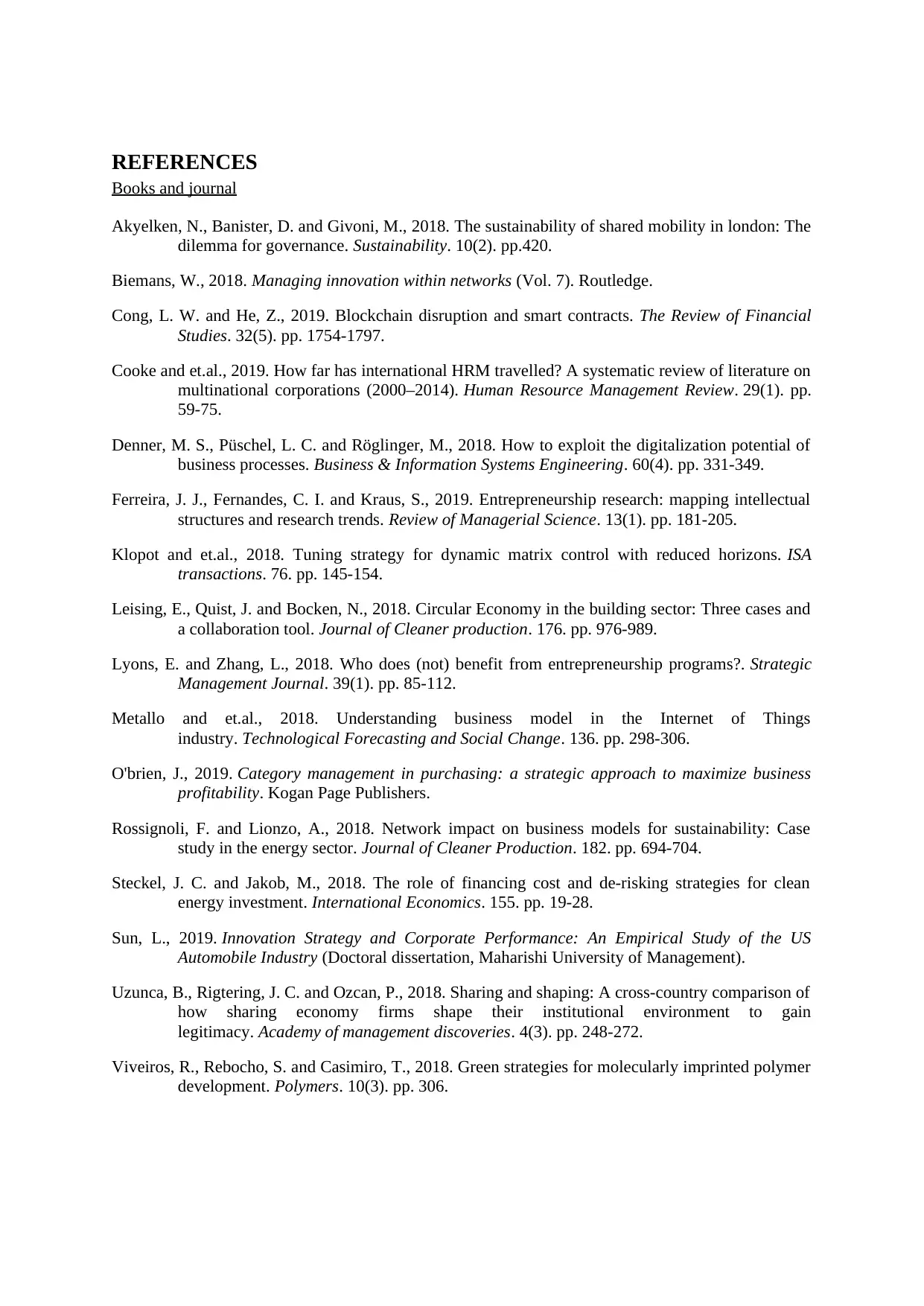
REFERENCES
Books and journal
Akyelken, N., Banister, D. and Givoni, M., 2018. The sustainability of shared mobility in london: The
dilemma for governance. Sustainability. 10(2). pp.420.
Biemans, W., 2018. Managing innovation within networks (Vol. 7). Routledge.
Cong, L. W. and He, Z., 2019. Blockchain disruption and smart contracts. The Review of Financial
Studies. 32(5). pp. 1754-1797.
Cooke and et.al., 2019. How far has international HRM travelled? A systematic review of literature on
multinational corporations (2000–2014). Human Resource Management Review. 29(1). pp.
59-75.
Denner, M. S., Püschel, L. C. and Röglinger, M., 2018. How to exploit the digitalization potential of
business processes. Business & Information Systems Engineering. 60(4). pp. 331-349.
Ferreira, J. J., Fernandes, C. I. and Kraus, S., 2019. Entrepreneurship research: mapping intellectual
structures and research trends. Review of Managerial Science. 13(1). pp. 181-205.
Klopot and et.al., 2018. Tuning strategy for dynamic matrix control with reduced horizons. ISA
transactions. 76. pp. 145-154.
Leising, E., Quist, J. and Bocken, N., 2018. Circular Economy in the building sector: Three cases and
a collaboration tool. Journal of Cleaner production. 176. pp. 976-989.
Lyons, E. and Zhang, L., 2018. Who does (not) benefit from entrepreneurship programs?. Strategic
Management Journal. 39(1). pp. 85-112.
Metallo and et.al., 2018. Understanding business model in the Internet of Things
industry. Technological Forecasting and Social Change. 136. pp. 298-306.
O'brien, J., 2019. Category management in purchasing: a strategic approach to maximize business
profitability. Kogan Page Publishers.
Rossignoli, F. and Lionzo, A., 2018. Network impact on business models for sustainability: Case
study in the energy sector. Journal of Cleaner Production. 182. pp. 694-704.
Steckel, J. C. and Jakob, M., 2018. The role of financing cost and de-risking strategies for clean
energy investment. International Economics. 155. pp. 19-28.
Sun, L., 2019. Innovation Strategy and Corporate Performance: An Empirical Study of the US
Automobile Industry (Doctoral dissertation, Maharishi University of Management).
Uzunca, B., Rigtering, J. C. and Ozcan, P., 2018. Sharing and shaping: A cross-country comparison of
how sharing economy firms shape their institutional environment to gain
legitimacy. Academy of management discoveries. 4(3). pp. 248-272.
Viveiros, R., Rebocho, S. and Casimiro, T., 2018. Green strategies for molecularly imprinted polymer
development. Polymers. 10(3). pp. 306.
Books and journal
Akyelken, N., Banister, D. and Givoni, M., 2018. The sustainability of shared mobility in london: The
dilemma for governance. Sustainability. 10(2). pp.420.
Biemans, W., 2018. Managing innovation within networks (Vol. 7). Routledge.
Cong, L. W. and He, Z., 2019. Blockchain disruption and smart contracts. The Review of Financial
Studies. 32(5). pp. 1754-1797.
Cooke and et.al., 2019. How far has international HRM travelled? A systematic review of literature on
multinational corporations (2000–2014). Human Resource Management Review. 29(1). pp.
59-75.
Denner, M. S., Püschel, L. C. and Röglinger, M., 2018. How to exploit the digitalization potential of
business processes. Business & Information Systems Engineering. 60(4). pp. 331-349.
Ferreira, J. J., Fernandes, C. I. and Kraus, S., 2019. Entrepreneurship research: mapping intellectual
structures and research trends. Review of Managerial Science. 13(1). pp. 181-205.
Klopot and et.al., 2018. Tuning strategy for dynamic matrix control with reduced horizons. ISA
transactions. 76. pp. 145-154.
Leising, E., Quist, J. and Bocken, N., 2018. Circular Economy in the building sector: Three cases and
a collaboration tool. Journal of Cleaner production. 176. pp. 976-989.
Lyons, E. and Zhang, L., 2018. Who does (not) benefit from entrepreneurship programs?. Strategic
Management Journal. 39(1). pp. 85-112.
Metallo and et.al., 2018. Understanding business model in the Internet of Things
industry. Technological Forecasting and Social Change. 136. pp. 298-306.
O'brien, J., 2019. Category management in purchasing: a strategic approach to maximize business
profitability. Kogan Page Publishers.
Rossignoli, F. and Lionzo, A., 2018. Network impact on business models for sustainability: Case
study in the energy sector. Journal of Cleaner Production. 182. pp. 694-704.
Steckel, J. C. and Jakob, M., 2018. The role of financing cost and de-risking strategies for clean
energy investment. International Economics. 155. pp. 19-28.
Sun, L., 2019. Innovation Strategy and Corporate Performance: An Empirical Study of the US
Automobile Industry (Doctoral dissertation, Maharishi University of Management).
Uzunca, B., Rigtering, J. C. and Ozcan, P., 2018. Sharing and shaping: A cross-country comparison of
how sharing economy firms shape their institutional environment to gain
legitimacy. Academy of management discoveries. 4(3). pp. 248-272.
Viveiros, R., Rebocho, S. and Casimiro, T., 2018. Green strategies for molecularly imprinted polymer
development. Polymers. 10(3). pp. 306.
Secure Best Marks with AI Grader
Need help grading? Try our AI Grader for instant feedback on your assignments.

Online:-
Stakeholder Matrix. 2020. {Online}. Available through
< https://www.lucidchart.com/blog/how-to-do-a-stakeholder-analysis>
Stakeholder Matrix. 2020. {Online}. Available through
< https://www.lucidchart.com/blog/how-to-do-a-stakeholder-analysis>
1 out of 17
Related Documents
Your All-in-One AI-Powered Toolkit for Academic Success.
+13062052269
info@desklib.com
Available 24*7 on WhatsApp / Email
![[object Object]](/_next/static/media/star-bottom.7253800d.svg)
Unlock your academic potential
© 2024 | Zucol Services PVT LTD | All rights reserved.





